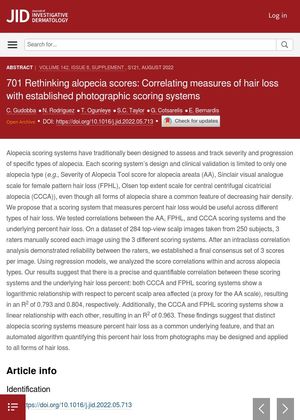Rethinking Alopecia Scores: Correlating Measures of Hair Loss with Established Photographic Scoring Systems
July 2022
in “
Journal of Investigative Dermatology
”

TLDR The conclusion suggests that a new system for measuring hair loss could be created using automated analysis of photographs.
The study "Rethinking alopecia scores: Correlating measures of hair loss with established photographic scoring systems" proposes a new scoring system that measures percent hair loss across different types of alopecia. The study tested correlations between the Severity of Alopecia Tool score for alopecia areata (AA), Sinclair visual analogue scale for female pattern hair loss (FPHL), and Olsen top extent scale for central centrifugal cicatricial alopecia (CCCA) scoring systems and the underlying percent hair loss. The study used a dataset of 284 top-view scalp images from 250 subjects. The results showed a precise and quantifiable correlation between these scoring systems and the underlying hair loss percent. Both CCCA and FPHL scoring systems showed a logarithmic relationship with respect to percent scalp area affected, resulting in an R2 of 0.793 and 0.804, respectively. Additionally, the CCCA and FPHL scoring systems showed a linear relationship with each other, resulting in an R2 of 0.963. The findings suggest that an automated algorithm quantifying percent hair loss from photographs may be designed and applied to all forms of hair loss.



